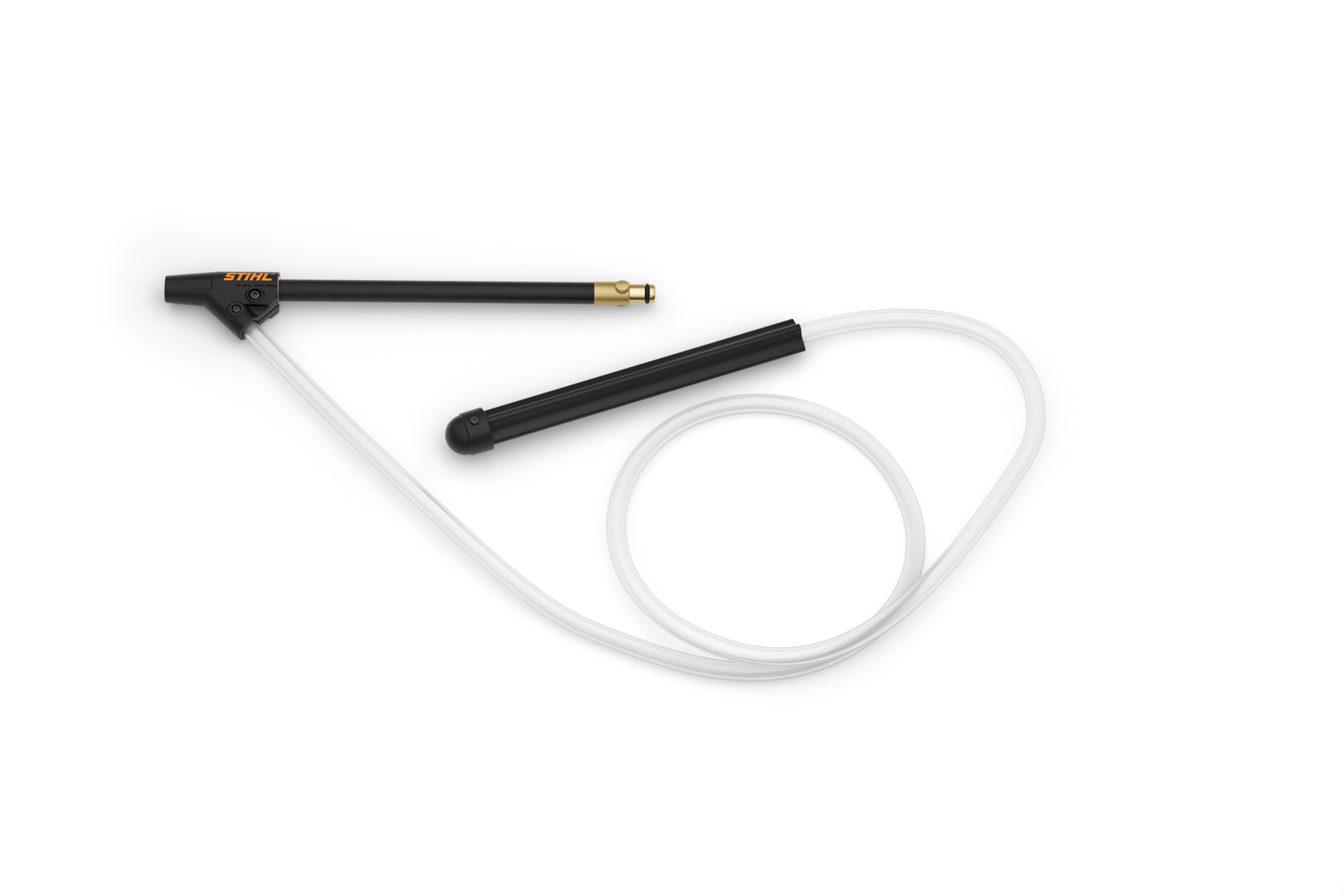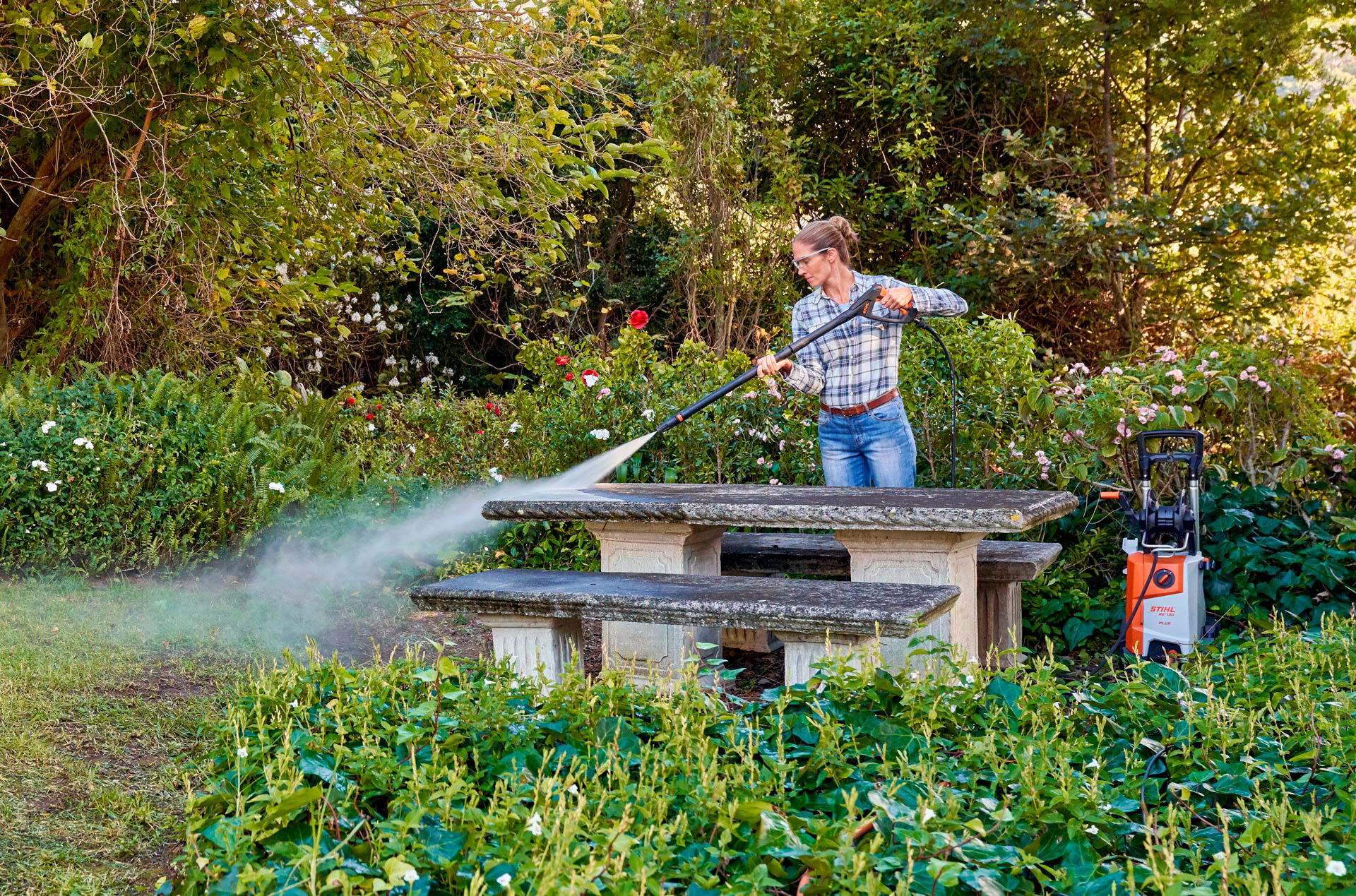Wet sandblasting: the right way to sandblast using pressure washers
Wet sandblasting removes tough dirt from durable surfaces. We show you how to achieve optimum results.
16.07.2024

Overview: Sandblasting using a pressure washer
Sandblasting using pressure washers, also known as wet sandblasting, is suitable for cleaning durable surfaces such as metal, stone and concrete.
You can upgrade any pressure washer with a STIHL wet sandblasting kit.
Wet sandblasting works best with special sand granulate. The use of quartz sand is prohibited by law and poses a health risk.
Removed dirt and used blasting granulate should be collected and disposed of properly after use.
Special blasting granulate such as the STIHL SB 90 blasting granulate is used for wet sandblasting. The mixture should be adapted for effective sandblasting with a pressure washer and should be of the correct grain size. Ready-to-use granulate mixtures are available ready for immediate use.
A grain size of 0.2 to 1.0 millimetres is suitable for wet blasting if you use the STIHL wet sandblasting set. STIHL SB 90 blasting granulate is ready-mixed and has the correct grain size to achieve optimum results when sandblasting with a pressure washer.
The pressure used during wet blasting varies. Depending on the type and properties of the material to be cleaned and the degree of soiling, low pressure may be sufficient to achieve good results. If needed, increase the pressure for enhanced cleaning performance. But be aware that excessive pressure can damage the surface being cleaned, so you should take a cautious approach.
Sandblasting with a pressure washer can be performed with the appropriate wet sandblasting set. This is available as an accessory for all STIHL pressure washers and is attached to the spray lance in place of the nozzle.
Areas of use: suggested applications
Wet sandblasting works a little like sandpaper. High-pressure sandblasting removes rust and dirt from durable surfaces such as metal, stone and concrete. While grinding machines are great for cleaning flat surfaces, wet blasting with a high-pressure washer is best for uneven surfaces.
So ideal areas of application for wet sandblasting include:
Corrugated metal fences
Dirty masonry
Small, durable metal parts
Items required for wet sandblasting

There are three essential components for wet sandblasting: a pressure washer, a wet sandblasting attachment, and appropriate sand granulate such as STIHL SB 90 blasting granulate.
Instructions: How wet sandblasting works
Before you start the actual wet sandblasting, you should prepare the surface for cleaning.
For example, if you want to remove rust from a metal fence, first disassemble it to its individual elements. Spread out a tarpaulin to collect the removed rust and blasting granulate, and dispose of them properly after the work has been completed. This preparation also ensures that you can maintain an optimum distance at all times and that the blasting granulate only hits the surface to be cleaned; delicate plants in the flowerbed behind the fence remain protected.
Always wear your personal protective equipment when working with pressure washers. This includes safety glasses, non-slip footwear and gloves. Find out more information in the operating instructions for your product. Before using your power tool for the first time, fully familiarise yourself with it and ensure that it is in flawless condition before each use. On request, your STIHL dealer will be happy to prepare your power tool for its first job, and will also advise you on models and sizes of protective clothing that you can try on at your leisure. Please remember that personal protective equipment is no substitute for working safely.


Preparing the pressure washer
Before starting up your pressure washer, make it ready for use as usual. Then fit the wet sandblasting attachment to it; attach it directly to the spray lance in place of the nozzle. Insert the other end of the wet sand-blasting attachment into a bucket containing the appropriate blasting granulate. The optimum quantity of granulate is automatically conveyed via the hose.

Only use suitable and non-hazardous sand granules for wet sandblasting. Avoid sandblasting with quartz sand in particular. Sandblasting with quartz sand is prohibited in many countries as even with breathing protection measures in place, its fine crystals can enter the lungs when used with pressure washers, and so it poses a health risk. STIHL SB 90 blasting granulate is made of iron-containing aluminosilicate glass and is silicone-free.
Video: The right technique for wet sandblasting
When sandblasting the effective area is a circle of about three centimetres in diameter. With this in mind, move the jet slowly over the surface to be cleaned, as if in slow motion, so that the mixture of water and blasting granulate can effectively remove the dirt. For stubborn dirt, carefully increase the pressure or repeat the process.
After use, empty the granulate hose.
Do not switch off your high-pressure cleaner immediately after work has been completed. First remove the end of the hose from the granulate bucket and then press and hold the spray gun until the granulate has completely drained out of the hose. The wet sandblasting set has now been emptied and is ready for storage.
Finally, dispose of the collected dirt and the blasting granulate properly.




